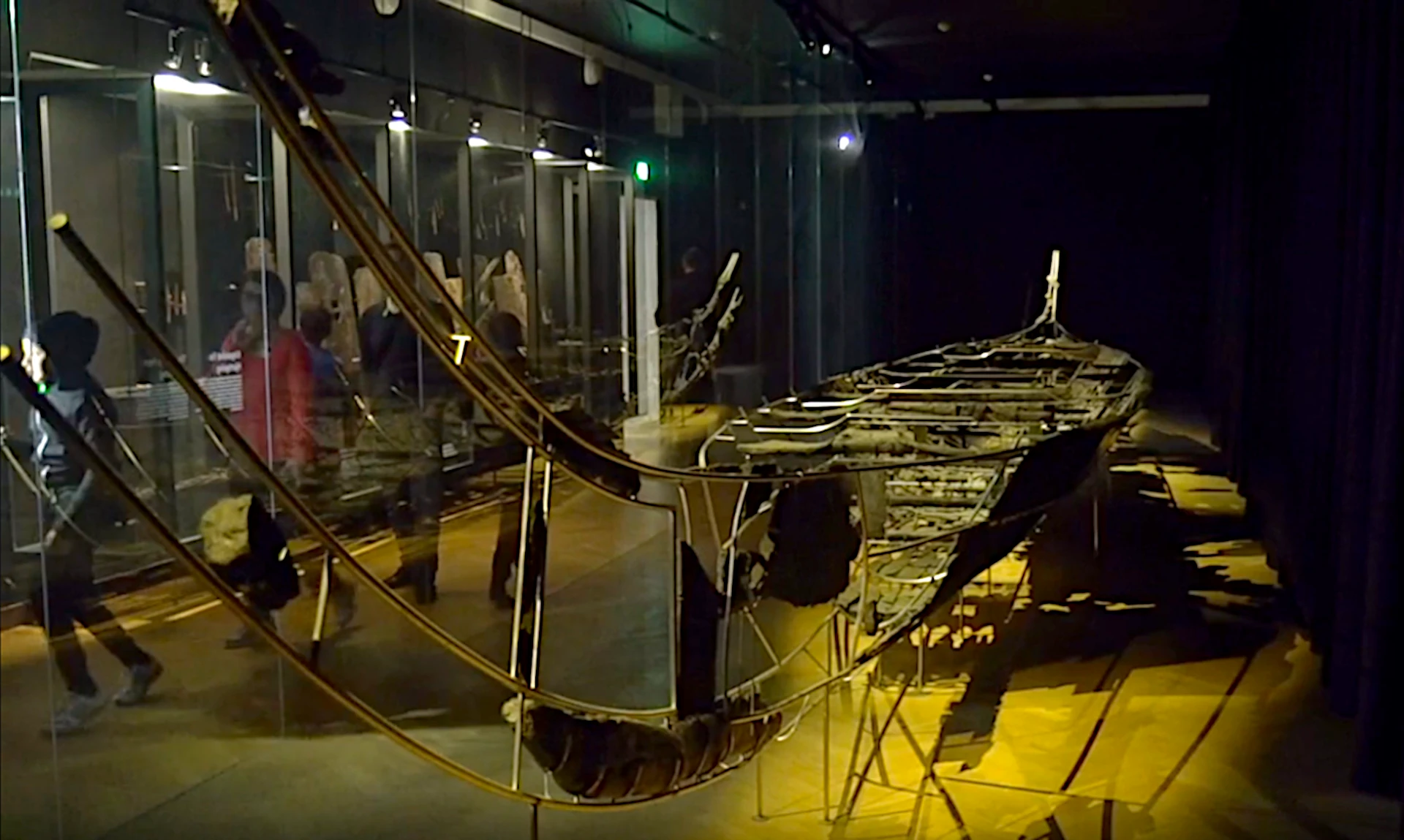The boat we wanted to build
The boat is the most impressive single piece of the Hjortspring find and is Scandinavia's oldest plank-built vessel found to date.
Basis
G. Rosenberg's descriptions of finds and Fr. Johannesen's drawings derived from them are the basis for:
- Rosenberg scale model as seen in Reconstructions
- The National Museum of Denmark's reconstruction of the find, see below
- Our reconstruction of the Hjortspring boat
It is a canoe more than 19 metres long, built from a bottom plank and a side and railing plank on each side, with the ends of the planks held together by two stern blocks.
This creates a keelless, round-bottomed vessel. The bottom plank and railing edges are extended at both ends in two 2 metre long upward curved horns (see picture above).
The boat is mostly made of lime wood, the bottom plank and stem blocks are locked together by a vertical oak plank (locking plank), the horns are also held together by a piece of oak, the oak pieces are tapped into the horns and fixed with oak nails.
An arrangement of 10 rib frames, made from a linden seat plank, two pillars (‘sneller’) and a cross piece of ash, all held together by a hazel branch, which is tied to cleats carved into the bottom and side planks. Cords for tying are made of lime bast. The same kind of string is used to sew the planks together, no metal is used anywhere in the boat!
The boat is 13 metres long and 2 metres wide inside, 0.7 metres high amidships and the plank thickness varies from 3 cm at the bottom to 1.5 cm at the railing.
The craftsmanship has been so good that the weight has only been around 500kg.
With a crew of 22 - 19 paddlers, captain, helmsman and beat maker (drums) - and their equipment on board, the total weight has been approximately 2,500 kg. The draught was approximately 30 cm.
This creates a keelless, round-bottomed vessel. The bottom plank and railing edges are extended at both ends in two 2 metre long upward curved horns (see picture above).
The boat is mostly made of lime wood, the bottom plank and stem blocks are locked together by a vertical oak plank (locking plank), the horns are also held together by a piece of oak, the oak pieces are tapped into the horns and fixed with oak nails.
An arrangement of 10 rib frames, made from a linden seat plank, two pillars (‘sneller’) and a cross piece of ash, all held together by a hazel branch, which is tied to cleats carved into the bottom and side planks. Cords for tying are made of lime bast. The same kind of string is used to sew the planks together, no metal is used anywhere in the boat!
The boat is 13 metres long and 2 metres wide inside, 0.7 metres high amidships and the plank thickness varies from 3 cm at the bottom to 1.5 cm at the railing.
The craftsmanship has been so good that the weight has only been around 500kg.
With a crew of 22 - 19 paddlers, captain, helmsman and beat maker (drums) - and their equipment on board, the total weight has been approximately 2,500 kg. The draught was approximately 30 cm.
What else was there
The Hjortspring find is much more than the boat itself, we have also gained a broad knowledge of the pre-Roman Iron Age weapons and equipment.
The following was found in more or less complete size and shape:
- More than 50 shields made of linden wood, the largest total find of preserved shields from the entire prehistory of Europe. They all have the same basic shape with lengths ranging from 61 to 68 cm and widths between 29 and 52 cm.
There are remains that suggest there must have been between 60 and 80 shields. - At least 169 spears, 138 of which were made of iron - of various shapes, from 10 to 13.5 cm long - and 31 of bone or antler. The longest spear shaft was 197 cm long.
- 11 swords of very different shapes, but all single-edged and with the grip tongue lying in the centre axis of the sword.
- Rust impressions of small thin iron rings were found during the excavation, according to Rosenberg, this layer covered 20 - 24 m², enough for 10 - 20 chainmails, the oldest known in Europe. They must have been imported from the Celts in central Europe (1).
- The first examples of turned wooden parts in northern Europe, small boxes about 10 cm in diameter.
Many different wooden parts were found for use in maritime transport.
As the original material looks now
Exhibition of the find at the National Museum of Denmark
- 1937. The first exhibition of the Hjortspring find - alum-glycol preservation.
- 1965. The boat was decommissioned due to preservation issues. It was disassembled, re-preserved and packed.
- 1986-1988. Due to lack of funds, the boat was not reinstalled until this period.
- 1988. The boat and other artefacts were put back on display in a newly refurbished exhibition space. Fl. Kaul published his book: Da våbnene tav, og Fl. Rieck & O. Crumlin-Pedersen: Både fra Danmarks Oldtid.
- 2003-2004. The exhibition Sejrens triumf was opened with the borrowed Nydambåd as one of the attractions and about spoils of war.
Hjortspringbåden and Tilia Alsie mentioned [p. 212 - 222].





